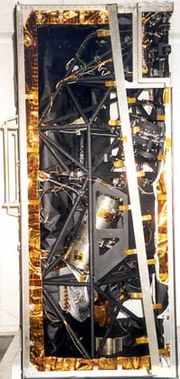
Faint Object Spectrograph
Encyclopedia

Spectrograph
A spectrograph is an instrument that separates an incoming wave into a frequency spectrum. There are several kinds of machines referred to as spectrographs, depending on the precise nature of the waves...
installed on the Hubble Space Telescope
Hubble Space Telescope
The Hubble Space Telescope is a space telescope that was carried into orbit by a Space Shuttle in 1990 and remains in operation. A 2.4 meter aperture telescope in low Earth orbit, Hubble's four main instruments observe in the near ultraviolet, visible, and near infrared...
. It was replaced by the Space Telescope Imaging Spectrograph
Space Telescope Imaging Spectrograph
The Space Telescope Imaging Spectrograph is a spectrograph, also with a camera mode, installed on the Hubble Space Telescope. It operated continuously from 1997 until a power supply failure in 2004. After repairs, it began operating again in 2009...
in 1997, and is now on display in the National Air and Space Museum
National Air and Space Museum
The National Air and Space Museum of the Smithsonian Institution holds the largest collection of historic aircraft and spacecraft in the world. It was established in 1976. Located in Washington, D.C., United States, it is a center for research into the history and science of aviation and...
in Washington DC.
FOS facts
- Instrument type: Spectrograph
- Wavelength range: 115 to 850 nm
A technical description of the construction and operation of the FOS can be found in NASA technical report CP-2244. The instrument used two digicon
Digicon
A digicon detector is a spatially resolved light detector using the photoelectric effect directly; it uses magnetic and electric fields operating in a vacuum to focus the electrons released from a photocathode by incoming light onto a collection of silicon diodes...
detectors, 'blue' and 'red', and had a spectral resolution of about 1300 over the 115nm to 850nm range. It had a number of apertures of varying size, but the aberration of the HST mirror meant that, until COSTAR was installed, the smallest apertures suffered very serious loss of light; even the largest 4.3-arcsecond aperture collected only 70% of the light from a point source.
The digicons suffered from inadequate magnetic shielding, which meant that a static image was smeared over several pixels; the red digicon suffered most from this. Also, either the blue detector or one of the mirrors in the system was contaminated in such a way as to remove sensitivity below 150nm; this was a serious problem since it makes the Lyman-alpha line at 121.6nm inaccessible.

